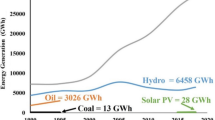Abstract
Results obtained from a study of the present state of the world’s power engineering, prospects for its future development, and its effect on the environment and climate for the period of up to 2200 are presented. It is shown that, given the framework of modern tendencies in the development of civilization, it is expected that the number of the population on the planet, consumption of energy in the world, and scales of negative effect on the atmosphere will all be stabilized.
Similar content being viewed by others
References
The Physical Science Basis. Contribution of Working Group I to the Fourth Assessment Report of the Intergovernmental Panel on Climate Change, Ed. by S. Solomon, D. Qin, M. Manning. et al., in Climatic Change 2007 (Cambridge, Cambridge University Press), Vol. 1.
O. Hoegh-Guldberg, P. J. Mumby, A. J. Hooten, et al., “Coral Reefs under Rapid Climate Change and Ocean Acidification,” Science 318(5857), 1737–1742 (2007).
J. E. Hansen, “A Slippery Slope: How Much Global Warming Constitutes ‘Dangerous Anthropogenic Interference?’” Climatic Change 68(3), 269–279 (2005).
K. Keller, G. Yohe, and M. Schlesinger, “Managing the Risks of Climatic Thresholds: Uncertainties and Information Needs,” Climatic Change 91(1–2), 5–10 (2008).
V. V. Klimenko, Climate: an Unread Chapter of the History (MEI, Moscow, 2009) [in Russian].
V. V. Klimenko, “The Main Climatic Rhythms of Holocene,” Dokl. Ross. Akad. Nauk 357(3), 399–402 (1997).
V. V. Klimenko, A. V. Klimenko, and A. G. Tereshin, “Power Engineering and the Climate on the Eve of the New Century: Forecasts and Reality,” Teploenergetika, No. 10, 61–66 (2001) [Therm. Eng., No. 10 (2001)].
V. V. Klimenko, L. N. Khrustalev, O. V. Mikushina, et al., “Climate Changes and Dynamics of the Perennially Frozen Soil Strata in the Northwest of Russia in the Nearest 300 Years,” Kriosfera Zemli XI(3), 3–13 (2007).
World Population Prospects. 2008 Revision (UN, 2009).
World Population to 2300 (UN, 2004).
Global Energy Perspectives (WEC/IIASA, 1998).
Special Report on Emission Scenarios (IPCC, 2000).
World Energy Outlook 2008 (IEA, 2008).
International Energy Outlook 2009 (EIA, 2009).
Exploring the Future: Energy Needs, Choices and Possibilities. Scenarios to 2050 (Shell, 2001).
Energy Technology Perspectives (OECD/IEA, 2008).
Energy Policy Scenarios to 2050 (WEC, 2007).
V. V. Klimenko and A. V. Klimenko, “Will the Development of Power Engineering Lead to Climatic Collapse?” Teploenergetika, No. 10, 6–11 (1990).
S. Yu. Snytin, V. V. Klimenko, and M. V. Fedorov, “A Forecast of the Development of Power Engineering and Emission of Carbon Dioxide into the Atmosphere for the Period of Up to 2100,” Dokl. Ross. Akad. Nauk 336(4), 476–480 (1994).
V. V. Klimenko, A. V. Klimenko, and A. G. Tereshin, “Reducing Emissions of Trace Greenhouse Gases as an Alternative to Decreasing Emissions of Carbon Dioxide: Part I,” Teploenergetika, No. 6, 6–12 (2000) [Therm. Eng., No. 6 (2000)].
V. V. Klimenko, A. V. Klimenko, and A. G. Tereshin, “Reducing Emissions of Small Greenhouse Gases as an Alternative to Decreasing Emissions of Carbon Dioxide: Part II,” Teploenergetika, No. 9, 43–46 (2000) [Therm. Eng., No. 9 (2000)].
N. Knowlton, “The Future of Coral Reefs,” Proc. Nat. Acad. Sci. 98(10), 5419–5425 (2001).
V. V. Klimenko, A. V. Klimenko, A. G. Tereshin, et al., “Changes of the Parameters of the Heating Period on the European Territory of Russia as a Result of Global Warming,” Izv. Ross. Akad. Nauk, Energetika, No. 2, 10–17 (2002).
O. D. Sirotenko, E. V. Abashina, and V. A. Romanenkov, “Simulating the Effect of Climate Changes on the Dynamics of Organic Carbon in Arable Soils, CO2 Emission, and Productivity of Agricultural Ecosystems,” Meteor., Gidrol., No. 8, 83–95 (2005).
V. C. Khon, I. I. Mokhov, M. Latif, et al., “Perspectives of Northern Sea Route and Northwest Passage in the Twenty-First Century,” Climatic Change 100(3–4), 757–768 (2009).
Assessment Report on Climate Changes and Their Consequences on the Territory of the Russian Federation, Ed. by. A. I. Bedritskii (Rosgidromet, Moscow, 2008) [in Russian].
M. Oppenheimer and R. B. Alley, “Ice Sheets, Global Warming, and Article 2 of the UNFCCC,” Climate Change 68(3), 257–267 (2005).
M. Vellinga and R. A. Wood, “Global Climatic Impacts of a Collapse of the Atlantic Thermohaline Circulation,” Climatic Change 54(3), 251–267 (2002).
R. B. Alley, J. Marotzke, W. D. Nordhause, et al., “Abrupt Climate Change,” Science 299(5615), 2005–2010 (2003).
Energy Statistics Yearbook 2006 (UN, NewYork, 2009).
BP Statistical Review of World Energy 2009 (BP, London, 2009), http://www.bp.com/statisticalreview.
P. Brohan, J.J. Kennedy, I. Harris, et al., “Uncertainty Estimates in Regional and Global Observed Temperature Changes: a New Dataset from 1850,” J. Geophys. Res. 111(D12106), (2006).
V. V. Klimenko, The Cold Climate of the Early Subatlantic Epoch in the Northern Hemisphere (MEI, Moscow, 2004) [in Russian].
Author information
Authors and Affiliations
Additional information
Original Russian Text © V.V. Klimenko, A.G. Tereshin, 2010, published in Teploenergetika.
The results presented in this paper were obtained in the course of scientific research works carried out within the framework of the Federal target programs “Investigations and Developments in the First-Priority Lines of the Development of the Scientific and Technological Complex of Russia for 2007–2012” and “Scientific and Scientific-Pedagogical Staff for Innovative Russia for 2009–2013.”
Rights and permissions
About this article
Cite this article
Klimenko, V.V., Tereshin, A.G. World power engineering and global climate after the year 2100. Therm. Eng. 57, 1035–1041 (2010). https://doi.org/10.1134/S0040601510120074
Published:
Issue Date:
DOI: https://doi.org/10.1134/S0040601510120074




